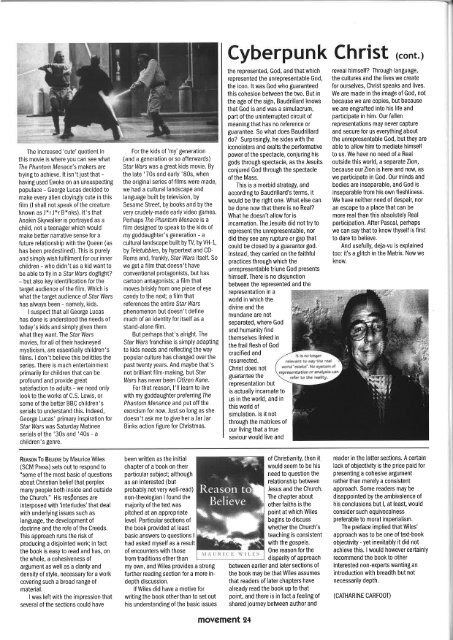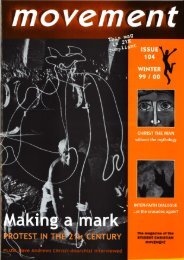Movement 103
Create successful ePaper yourself
Turn your PDF publications into a flip-book with our unique Google optimized e-Paper software.
The increased 'cute' quotient in<br />
this movie is where you can see what<br />
The Phantom Menace's makers are<br />
trying to achieve. lt isn'tjust that -<br />
having used Ewoks 0n an unsuspecting<br />
populace - George Lucas decided to<br />
make every alien cloyingly cute in this<br />
film (l shall not speak of the creature<br />
known as J*r.,1*r B*nks). lt's that<br />
Anakin Skywalker is portrayed as a<br />
child, not a teenager which would<br />
make better narrative sense for a<br />
future relationship with the Queen (as<br />
has been predestined). This is purely<br />
and simply wish fulfilment for our inner<br />
children - who didn't as a kid want to<br />
be able to fly in a Star Wars do$ight?<br />
- but also key identification for the<br />
target audience of the film. Which is<br />
what the target audience of Star Wars<br />
has always been - namely, kids.<br />
I suspectthat all George Lucas<br />
has done is understood the needs of<br />
today's kids and simply given them<br />
what they want. The Star Wars<br />
movies, for all of their hackneyed<br />
mysticism, are essentially children's<br />
f ilms. I don't believe this belittles the<br />
series. There is much entertainment<br />
primarily for children that can be<br />
profound and provide great<br />
satisfaction to adults - we need only<br />
look to the works of C.S. Lewis, or<br />
some of the better BBC children's<br />
serials to understand this. lndeed,<br />
George Lucas' primary inspiration for<br />
Star Wars was Saturday Matinee<br />
serials of the '30s and '40s - a<br />
children's genre.<br />
For the kids of 'my' generation<br />
(and a generation orso afterwards)<br />
Star Wars was a great kids movie. By<br />
the late '70s and early '80s, when<br />
the original series of films were made,<br />
we had a cultural landscape and<br />
language built by television, by<br />
Sesame Street, by books and by the<br />
very crudely-made early video games.<br />
Perhaps The Phantom Menace is a<br />
film designed to speak to the kids of<br />
my goddaughter's generation - a<br />
cultural landscape builtbyTV, byVH-1,<br />
by Teletubbies, by hypertext and CD-<br />
Roms and, frankly, Star Wars itself. So<br />
we get a film that doesn't have<br />
conventional protagonists, but has<br />
cartoon antagonists; a film that<br />
moves briskly from one piece of eye<br />
candy to the next; a film that<br />
references the entire Star Wars<br />
phenomenon but doesn't define<br />
much of an identig for itself as a<br />
stand-alone film.<br />
But perhaps that's alright. The<br />
Star Wars franchise is simply adapting<br />
to kids needs and reflecting the way<br />
popular culture has changed overthe<br />
past twenty years. And maybe that's<br />
not brilliant film-making, but Star<br />
Wars has never been Citizen Kane.<br />
For that reason, l'll learn to live<br />
with my goddaughter preferring lhe<br />
Phantom Menance and putoffthe<br />
exorcism for now. Just so long as she<br />
doesn't ask me to give her a Jar.Jar<br />
Binks action figure for Christmas.<br />
Cyberpunk Christ<br />
the represented, God, and thatwhich<br />
represented the unrepresentable God,<br />
the icon. ltwas God who guaranteed<br />
this cohesion between the two. But in<br />
the age ofthe sign, Baudrillard knows<br />
that God is and was a simulacrum,<br />
part ofthe unintenupted circuit of<br />
meaning that has no reference or<br />
guarantee. So what does Baudrillard<br />
do? Surprisingly, he sides with the<br />
iconolaters and exalts the performative<br />
power of the spectacle, conjuring his<br />
gods through spectacle, as the Jesuits<br />
conjured God through the spectacle<br />
ofthe Mass.<br />
This is a morbid strategy, and<br />
according to Baudrillard's terms, it<br />
would be the right one. What else can<br />
be done now that there is no Real?<br />
What he doesn't allow for is<br />
incarnation. The Jesuits did not try to<br />
represent the unrepresentable, nor<br />
did they see any rupture or gap that<br />
could be closed by a guarantorgod.<br />
Instead, they canied on the faithful<br />
practices through which the<br />
unrepresentable triune God presents<br />
himself. There is no disjunction<br />
between the represented and the<br />
representation in a<br />
world in which the<br />
divine and the<br />
mundane are not<br />
separated, where God<br />
and humanity find<br />
themselves linked in<br />
the frail flesh of God<br />
us in the world, and in<br />
this world of<br />
simulation. ls it not<br />
through the matrices of<br />
our living that a true<br />
saviour would live and<br />
(cont.)<br />
reveal himself? Through language,<br />
the cultures and the lives we create<br />
for ourselves, Christ speaks and lives.<br />
We are made in the image of God, not<br />
because we are copies, but because<br />
we are engrafted into his life and<br />
participate in him. Ourfallen<br />
representations may never capture<br />
and secure for us everything about<br />
the unrepresentable God, but they are<br />
able to allow him to mediate himself<br />
to us. We have no need of a Real<br />
outside this world, a separate Zion,<br />
because ourZion is here and now, as<br />
we participate in God. Our minds and<br />
bodies are inseparable, and God is<br />
inseparable from his own fleshliness.<br />
We have neither need of despair, nor<br />
an escape to a place that can be<br />
more real than this absolutely Real<br />
participation. After Pascal, perhaps<br />
we can say that to know thyself is first<br />
to dare to believe.<br />
And usefully, deja-vu is explained<br />
too: it's a glitch in the Matrix. Now we<br />
know.<br />
crucified and<br />
Itlg M lonqcr<br />
resunected.<br />
rcldantto 9a! lhc rcal<br />
Christ does not wda"di6l5".No tyetq ol<br />
o. anavi' can<br />
guarantee the<br />
rcfcr t r)v @lW'<br />
representation but<br />
is actually incarnate to<br />
Rrnsoru To Beuwe by Maurice Wiles<br />
(SCM Press) sets out to respond to<br />
"some of the most basic of questions<br />
about Christian belief that perplex<br />
many people both inside and outside<br />
the Church." His responses are<br />
interposed with'interludes' that deal<br />
with underlying issues such as<br />
language, the development of<br />
doctrine and the role of the Creeds.<br />
This approach runs the risk of<br />
producing a disjointed work; in fact<br />
the book is easy to read and has, on<br />
the whole, a cohesiveness of<br />
argument as well as a clarity and<br />
density of style, necessary for a work<br />
covering such a broad range of<br />
material.<br />
I was left with the impression that<br />
several of the sections could have<br />
been written as the initial<br />
chapter of a book on their<br />
particular subject; although<br />
as an interested (but<br />
probably not very well-read)<br />
non-theologian I found the<br />
majority of the text was<br />
pitched at an appropriate<br />
level. Particular sections of<br />
the book provided at least<br />
basic answers to questions I<br />
had asked myselfas a result<br />
of encounters with those<br />
from traditions other than<br />
my own, and Wiles provides a strong<br />
further reading section for a more indepth<br />
discussion.<br />
lf Wiles did have a motive for<br />
writing the book other than t0 set out<br />
his understanding of the basic issues<br />
of Christianity, then it<br />
would seem to be his<br />
need to question the<br />
relationship between<br />
Jesus and the Church.<br />
The chapter about<br />
other faiths is the<br />
point at which Wiles<br />
begins to discuss<br />
whether the Church's<br />
teaching is consistent<br />
with the gospels.<br />
One reason for the<br />
disparity of approach<br />
between earlier and later sections of<br />
the book may be that Wiles assumes<br />
that readers of later chapters have<br />
already read the book up to that<br />
point, and there is in fact a feeling of<br />
shared journey between author and<br />
reader in the latter sections. A certain<br />
lack of objectivity is the price paid for<br />
presenting a cohesive argument<br />
rather than merely a consistent<br />
approach. Some readers may be<br />
disappointed by the ambivalence of<br />
his conclusions but l, at least, would<br />
consider such equivocalness<br />
preferable to moral imperialism.<br />
The preface implied that Wiles'<br />
approach was to be one oftext-book<br />
objectivity - yet inevitably it did not<br />
achieve this. I would however certainly<br />
recommend the book to other<br />
interested n0n-experts wanting an<br />
introduction with breadth but not<br />
necessarily depth.<br />
(CATHARINE CARFOOT)<br />
movement 24
















